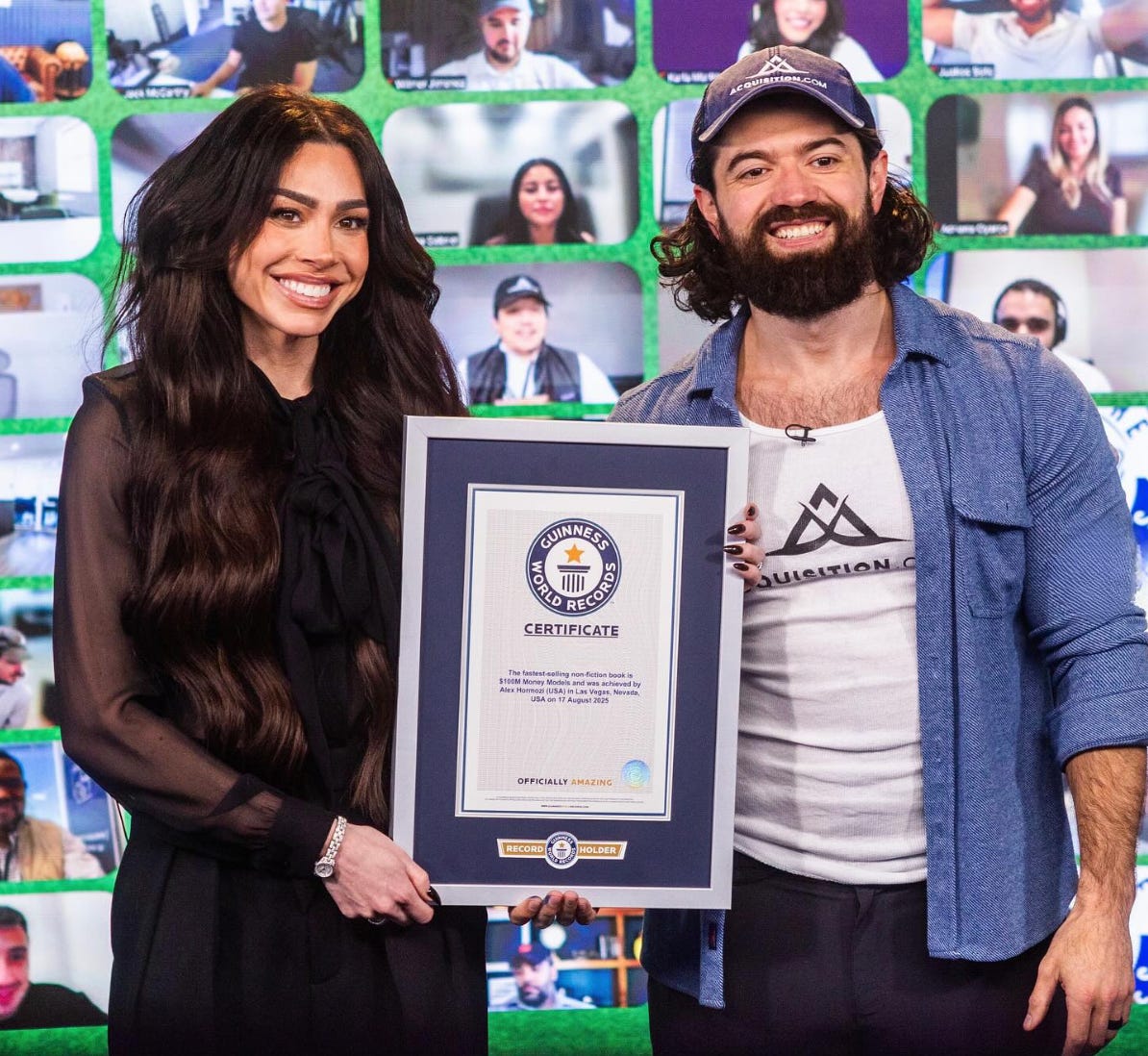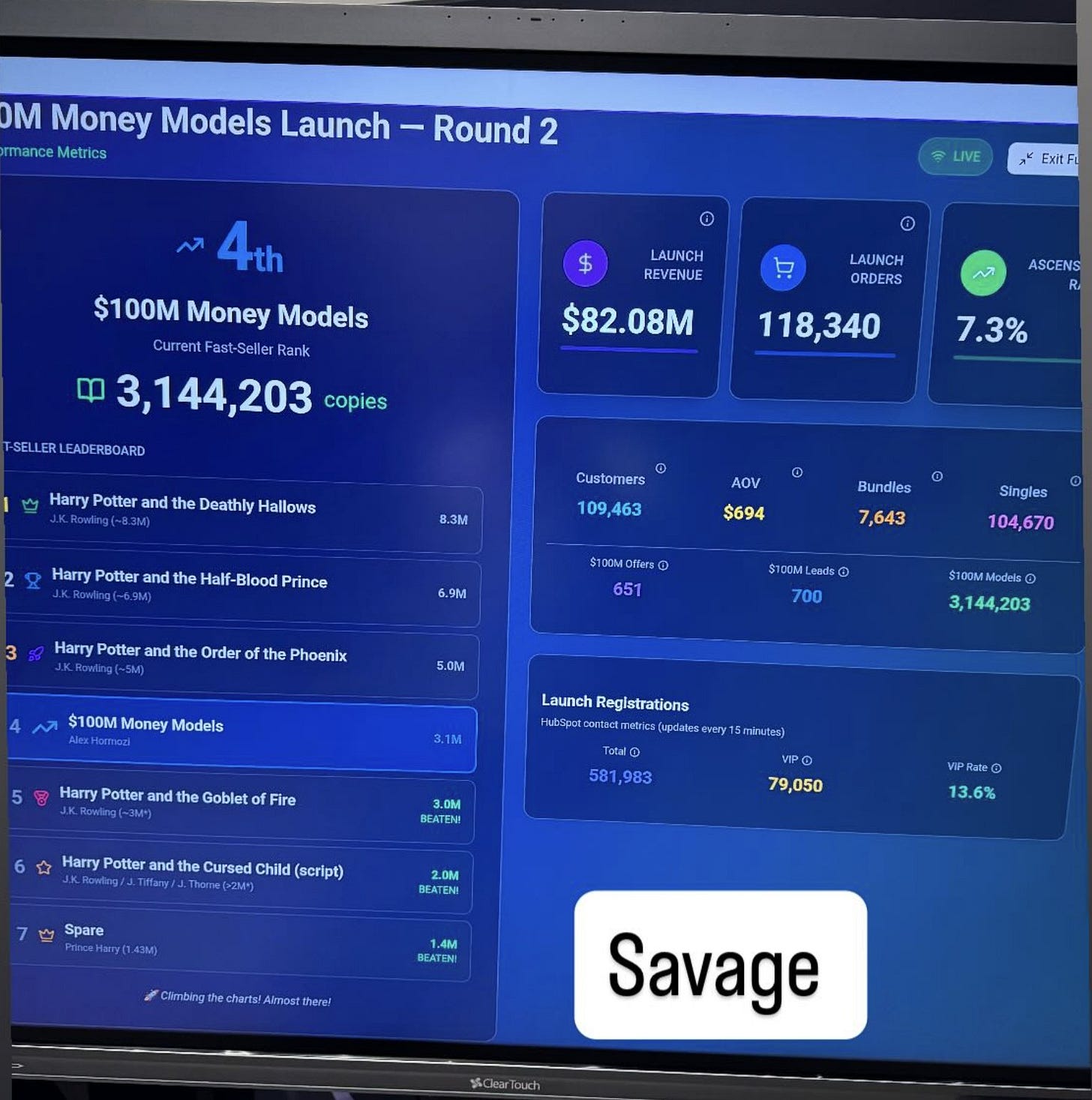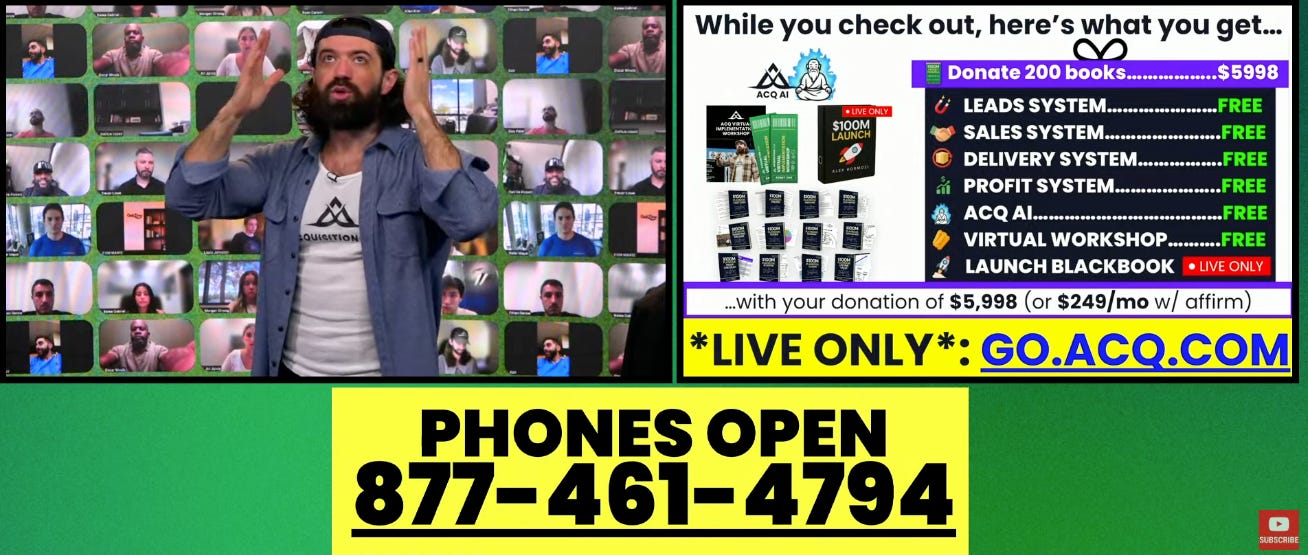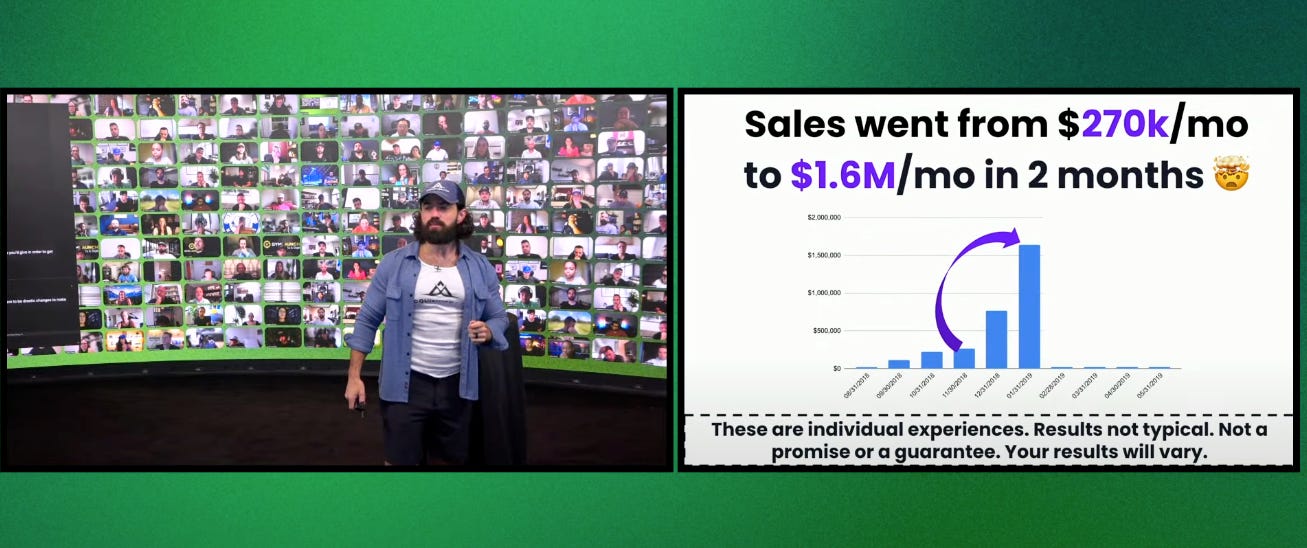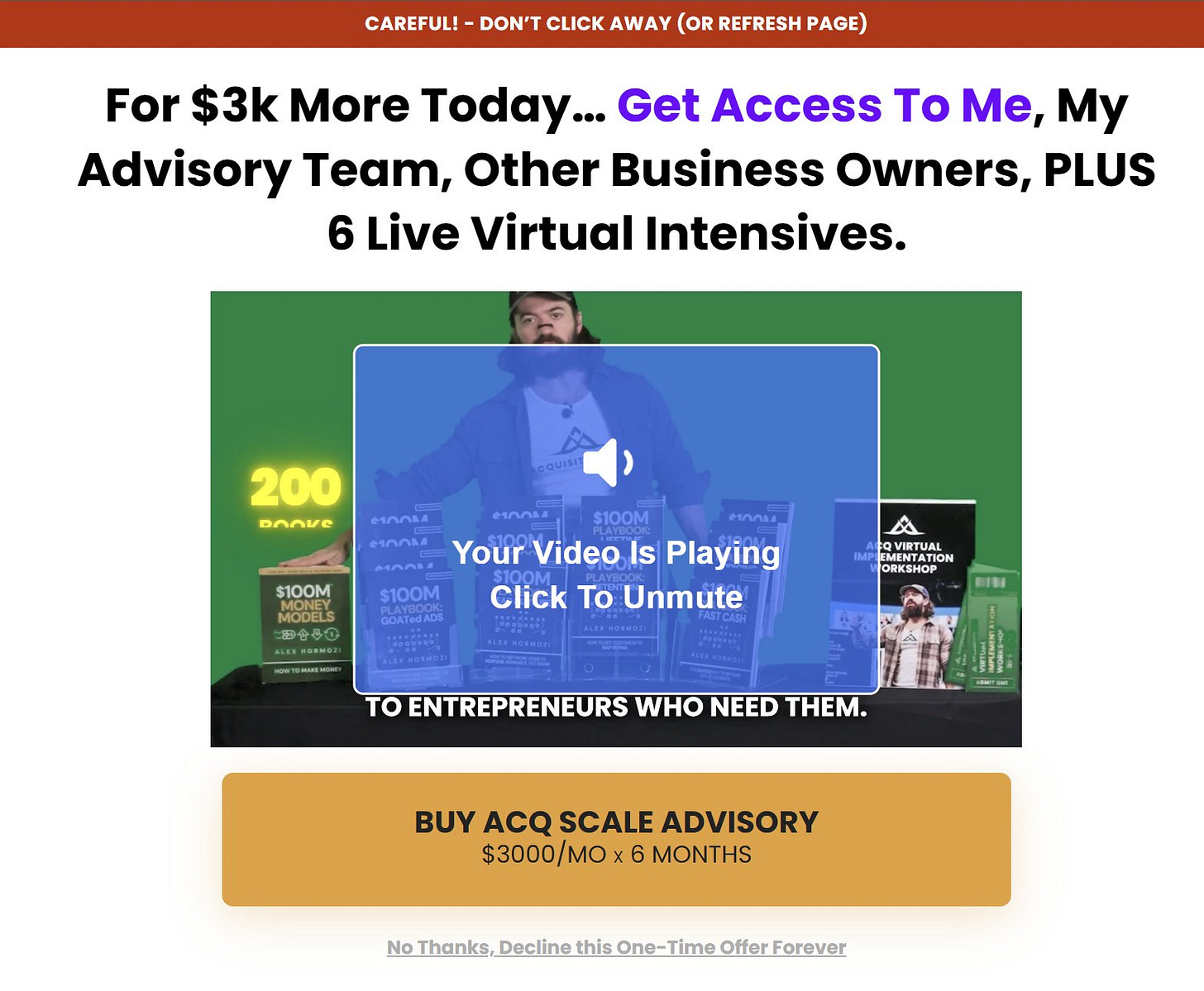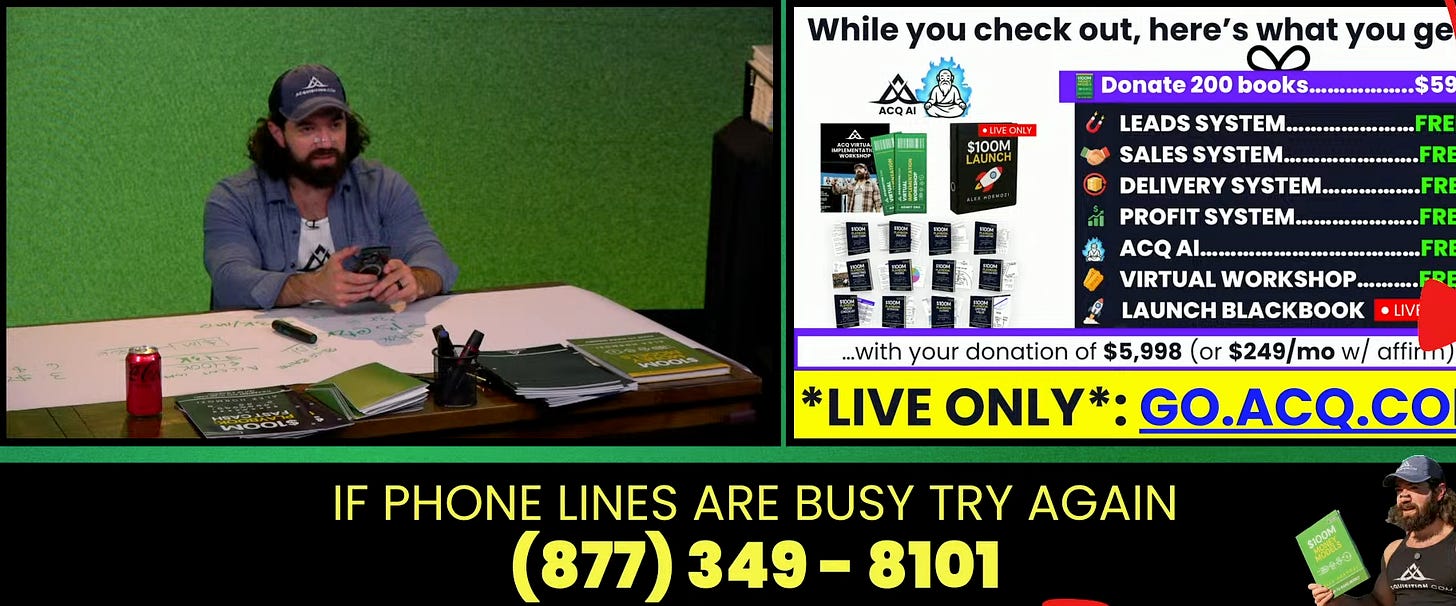How Alex Hormozi ACTUALLY Made $100m From His Book Launch
How To Emulate The Principles He Used In His Webinar For Yourself
Unless you have been living under a rock since Saturday morning, you’ll know that Alex Hormozi launched his book ‘$100M Money Models’, and funnily enough, cleared $100m from it in a single weekend.
He now has the Guinness World Record for the most non-fiction books sold in 24 hours, and is only topped in fiction by Harry Potter.
(Which is absolutely fucking insane for someone in our industry to do.)
So, say what you want about Hormozi and the way he did it…
The results are undeniable.
Which is why it would probably be a good idea for us to take what we can out of Hormozi’s latest launch and apply it to our own businesses, right?
Well, that’s exactly what I am going to be doing here, but what I don’t want to do is break down the obvious.
I have seen a bunch of people coming out over the weekend, and I’m sure it won’t stop soon…
Making videos akin to “Hormozi $100m Webinar Funnel Breakdown.”
I can assure you that 90% of these videos are garbage.
If you copy his funnel, his script, or most things about the campaign…
You are not going to make $100M from a webinar.
Simple as that.
Why?
Because you are not Hormozi.
In fact, any skilled marketer will be able to tell you there was nothing special about his webinar funnel.
So, I’m not here to spin this up and tell you “Webinars are the best funnel to use”
However, what you can do, and what I will be doing for you in this post…
What I AM going to do is show you how you can apply the PRINCIPLES he used in the launch for yourself, or your clients.
Most of which derive from the greatest webinar architect alive to date, Jason Fladlien, and some things I spotted from what I do for clients too.
As someone who has studied and applied Fladlien’s body of work diligently into the service we provide for our DFY and DWY clients…
I have developed an eagle eye for the techniques he used, and it’s clear to see his fingerprints all over Hormozi’s latest launch.
So, without further ado, here are the principles you can take away and apply to your first or next webinar, based on the Hormozi launch.
Fladlien’s $250 Million 14-Step Webinar Framework
If you have watched any of my videos / read any of my articles before, you’ll know that I don’t pretend to have some ‘secret sauce’ when it comes to writing webinars.
I would be a fraud to do so.
I pay homage directly to Fladlien and I religiously use his 14-step framework whenever I am sitting down to write a webinar for a client.
In fact, whenever I try and deviate from it, the webinar doesn’t have the same flow or feeling.
Not only is this framework battle-tested and proven to work for Jason, but also for everyone who comes across it and uses it properly.
Almost everyone I have ever spoken to who does webinars uses this framework.
It is the same framework Hormozi used this past weekend to become the fastest-selling non-fiction author in the world.
If that isn’t proof for you, what is?
So, why is Fladlien’s framework so effective, and why do so many of the best webinars in the world have this formula behind them?
I like to think of it this way.
“The order of the copy matters more on a webinar than the copy itself.”
You could have the best copy in the world, but if you don’t have a clear path to pitching the offer…
Your webinar is going to feel scattered, messy, and the flow will kill conversions because your audience hasn’t been put through the necessary emotional buildup to take action.
That’s not to say copy isn’t important, because it is.
But you wouldn’t pitch on a sales call without doing the discovery, and you wouldn’t pitch on a webinar without the proper framing either.
Fladlien does this differently from almost all other webinar guys, and I won’t dive TOO in-depth into the framework itself, as Jason has plenty of videos going over this.
But what I will do is go over the highlights of what he does differently and how Hormozi applied it in the recent launch - with examples.
Hook:
Hormozi started off with 4/5 minutes of simply hooking the audience in before he properly started the presentation.
He made a big promise, briefly showed undeniable proof, and also teased a big surprise at the end.
This section in a webinar works fantastically because most people start off with the usual…
“Here’s what you’ll learn” or “here’s who I am”
Before they have actually given the viewer a reason to care.
A good film doesn’t start off with the hero’s backstory; it has an opening scene that sets the tone and hooks you in.
Webinars should be no different.
Set the tone, hook them in with something big, and work from there.
Pain:
Again, there’s no point in telling people anything unless you have given them a reason to care, and nothing gets people to care more than pain.
Pain is what gets people’s attention.
Humans are selfish.
We have problems, and we want them sorted, and we also want to know that the person presenting actually understands the problems we have.
Copywriting 101, I know.
So how did he actually implement this?
Hormozi spoke at length about the fact that the big reason most businesses fail is that they don’t have the right money model.
The pain of not having cash in the bank, despite working harder than an employee without the security of a job.
He linked a broad pain that business owners face (not making enough money) with the solution he was going to pitch at the end (Money Models).
Whether this is true or not, who knows?
Either way, here’s some notes you can use when writing your next webinar:
Wake them up from the nightmare before you show them the dream - they need to feel the full weight of the situation before they can be free.
They attended because something isn't working in their life/business, and they want the suffering to stop.
Objection Inventory: List every excuse, constraint, or limiting belief that would prevent them from taking action, big and small.
Address false beliefs that create real consequences in their results and life.
The Preemptive Strike: "I know some of you are thinking 'I can't do this because of X' - I'm going to show you exactly how to handle X, even if you have Y constraint."
Don't solve them yet - just acknowledge these barriers exist to show you understand their world.
Most presenters avoid this section out of fear, but your audience won't forget these limitations exist anyway.
Make their fears feel normal and solvable rather than insurmountable.
Tease:
The tease section is also known as the ‘what you’ll learn’ section, essentially just future pacing and connecting the training to an outcome to maintain retention.
He has already got your attention here with the hook and the pain, which is why the audience will now be receptive to what they are going to learn.
They know that if they stay, the pain he described will be alleviated as the problem will be solved.
It’s important that you link each of the things you are going to cover to a desired outcome in order to open a loop.
If I were doing a webinar for a Copywriting biz op, I wouldn’t just say…
“I’m going to show you how to write copy”.
You would say…
“I’m going to show you how to write copy so when you sign your first client, you aren’t worried about fulfilling the work for them”
Be specific, not generic.
Excite:
The tease section sets up what they are going to learn, the excite section sets up what their life will be like when they know it.
The ‘excite’ section of this webinar framework is all about expanding and putting them in their dream state, and linking it back to what they are going to learn on the webinar.
Think …
“And if you are able to apply what you learn today… here’s what will happen”
Hormozi did this by essentially telling the audience that the game of business will be a walk in the park for them if they just have a $100M Money Model.
Growth will no longer be hard for any of us anymore.
A state I imagine most of us would like to exist in.
Position:
Now it’s your job to show the audience why you, out of everyone else in the world, are more qualified than anyone to talk about {insert topic}.
Hormozi did this by:
Out-chadding the market and positioning himself among the biggest companies in the US, differentiating himself from ‘gurus’.
Showing how he used Money Models in all of his previous and current businesses to get to the point he is at today.
Hormozi already has a big following, so he obviously didn’t spend as much time on this as you would if you were doing a webinar to cold traffic.
In your case, something I see a lot of people get wrong is simply talking about their life story, rather than linking it to problems, pains and desires that their audience has.
This is one of the most important sections of the webinar, especially if you are not Hormozi. Don’t waste it.
Here are some notes that will help with this:
Results Hierarchy: Show your best results (proof of ceiling), average results (proof of consistency), and most recent results (proof of current relevance).
Position the mechanism/approach, not just yourself - you're the messenger of a superior method.
Authority through specificity - be the expert at THIS particular approach to THEIR specific problem.
Address why you're sharing this now and why they should listen to you over other options.
Credibility without arrogance - confident but relatable, successful but still connected to their struggles.
Share your journey from where they are to where you are now.
Unique Positioning Statement - "I'm the only person who teaches X to Y audience using Z method."
Paradigm:
The paradigm shift ties together the introduction of the webinar and leaves a nice, neat bow on it.
You want to give the audience that ‘aha’ moment, and give them full confidence that what you are about to teach them is:
A. Going to work for them.
B. Exactly what they need to get to where they want to be.
Hormozi does this perfectly, as demonstrated briefly in the slide above by making the declarative statement that Money Models are the only thing that guarantees you can stay in business.
Here’s some notes that will help you do this yourself:
Eliminate the risk of what they are doing. What is the one thing that if they understood, would change everything?
Create the "everything I thought I knew was wrong" moment that shifts their entire perspective.
Paradigm Shift Formula: "What you think is your biggest limitation is actually your greatest advantage."
Challenge industry orthodoxy and common wisdom that keep people stuck.
The Revelation: Introduce one core insight that, if truly understood, changes their entire approach.
Make them question their current strategy and see a completely new possibility.
Eliminate false choices - show them they don't have to choose between X and Y, there's a third option.
Connect this paradigm shift to why previous attempts failed.
The "Aha" Moment: Structure this so they literally say "Oh, this changes everything."
Mechanisms:
Now, this is what most people refer to as the ‘teaching’ section of the webinar, or if you follow Russell Brunson’s work, the ‘3 secrets’.
When I watch other people’s webinars, the teaching section can often feel monotonous and repetitive.
“Here’s this thing, this thing, this thing, now buy my course’ type vibe.
If you want to make your webinar feel like one ‘whole’ presentation altogether, you need to make sure that you aren’t just teaching, you are still persuading at the same time.
If you are interested, you can learn more about how we can help you do this.
Here’s how Hormozi did his (roughly), and how I write the teaching section for the webinars I do for my DFY and consult on with my clients.
3-5 elements that give them their desired output. If I could only teach people these topics, could I make them successful? The 3-5 most important things.
There are thousands and thousands of nuances and things that matter to be successful, but if I HAD TO break it down into 3-5 things, what would they be?
Each mechanism should be a pillar that, if removed, would cause the entire system to collapse.
Structure per mechanism: What it is → What happens without it → Why it matters → How to implement it → Success Example → Commitment
Progressive revelation - each mechanism builds on the previous one, creating a logical flow.
Make each mechanism feel both simple enough to understand and powerful enough to create transformation.
Commitment checkpoints - "Does this make sense? Can you see how this would work for your situation?"
The "Yes Ladder" - get agreement and commitment at each step to build momentum.
Include real examples and case studies for each mechanism to make them tangible.
Address implementation concerns - show them it's not just theory but practical and doable.
These are the notes I have in front of me when I write training sections.
If you have these notes beside you, and you go back and watch Hormozi’s webinar, he teaches the mechanisms almost as a story of how he applied them in his businesses over time.
Commitment:
This is where most people fuck up their webinars, and the audience immediately feels like the pitch is coming as soon as the training ends.
They rush through teaching their mechanisms, drop some mediocre value, and then immediately jump into their pitch.
But if your audience isn't 100% sold on the METHODOLOGY before you pitch the offer, they're never going to buy.
So, we emulate the ‘tie down’ section of a sales call through the commitment section.
Alex asked the audience a series of questions that got their commitment on what he had gone over so far, as well as getting commitment throughout the mechanisms.
"Do you see how this would work in your business? Can you imagine implementing this system? Are you convinced this is the path forward?"
You need to get them nodding their heads, saying "yes, this makes sense", before you ever mention the offer.
If they don't believe in the method, they'll never believe in your ability to help them implement it.
They need to be at the point where they would go and implement whatever you are teaching them, even if you didn’t offer them an easier path.
Transition:
In this section, you now call back to all of the amazing things you have shown the audience so far.
Not only putting them in a ‘value debt’, but also raising your frequency as the presenter, as you realise in this moment that you actually have delivered a good presentation.
You get yourself ready to offer them your product / service from a place of abundance, rather than seeming ‘scammy’ or ‘selly’.
Hormozi showed them what would happen if they implemented this, got them excited with the vision of what their new and improved business would look like with a money model, and then introduced them to…
Core Offer:
The offer.
Now, on a webinar, this isn’t the ACTUAL offer.
Think about the core offer as the thing you would sell someone if they booked a call with your team on a normal Thursday.
This would be like me pitching my DFY or DWY service.
Or if you are a coach, your normal offer.
On a webinar, you typically spend a small amount of time on this, as when people first see an offer, they are programmed to say ‘no’.
We aren’t trying to get them to say ‘yes’ to this straight away, as the rest of the pitch slowly warms them up and expands on the webinar offer.
Here’s how Hormozi presented it, and how I do this for my clients:
Naming Formula: An attractive name that automatically creates a desire for ownership. A bland name doesn’t cut it; an over-the-top name detracts from what you are selling.
One-Sentence Transformation Statement: If you only had one sentence to sell it, what would capture the entire value?
4-7 Core Highlights: Each with a compelling headline and 3-4 benefit-focused bullet points.
Proof Integration: Validate every claim with testimonials, case studies, or results.
Feature-to-Benefit Translation: Never just list what's included - explain what it does for them.
Address the "So What?" Test: Each element should pass the test of "why should they care about this?"
Transformation Framework: Show them going from the current state to the desired state through your program.
Price:
Now, this is one thing that you probably can’t copy (unless you want to sell your product for free).
This is where you anchor the price down (typical webinar fashion) until you get to the price of your offer.
Here’s how Hormozi and I structure the pricing section of a webinar.:
Value Anchoring Sequence: What it's worth to you → What others have gained → What others charge → What you normally charge → Special offer.
Have a clear, direct call to action now when you go to the chat.
Make the offer feel one-sided in favour of your customer. You want the customer to feel guilty about the amount of value you are giving to them.
ROI Demonstration: Show how quickly they could recoup the investment.
Bonuses:
Internet Marketing 101.
Hate it or love it, Hormozi used this to get people to buy 200 books that they probably aren’t going to read and didn’t want in the first place.
All just to get the bonuses that were involved.
I won’t talk about the fact that he framed it as a ‘donation’, but you have to give him his flowers.
But it’s important for you to understand that an offer on a webinar isn’t the same as a ‘normal’ offer.
In order to get people to act fast, there needs to be one-time offers that they can only get if they take action there and then.
And the only way to get the bonuses is to buy the core offer.
And even better?
The bonuses are free.
The bonuses are NOT part of ‘one whole offer’ and part of the whole price.
This is a mechanism you can use to turn a ‘no’ into a ‘yes’.
You want your bonuses to have MULTIPLE MODALITIES.
E.g. software, a consulting call, an AI tool, a physical book, digital PDFs, videos etc.
As you can see, Hormozi’s bonuses all had multiple modalities.
Fladlien used this to get people to buy an offer they had ALREADY bought, simply because they wanted the bonuses.
Scarcity:
This was the only part of the framework Hormozi DIDN’T implement.
Obviously, it wouldn’t have made sense for him to make it scarce if he was going for a Guinness World Record of most books sold, but usually, you can add in an element of scarcity…
AS LONG AS…
It’s attached to a legitimate reason as to why it’s scarce.
The whole 20 spots left gig won’t work with a sophisticated audience, but if you offer a 1-1 call as a bonus, they know you only have so much time in the day.
Urgency:
Again, another mechanism you can use to turn a ‘no’ into a ‘yes’ and a powerful one at that.
If you want the bonuses for free, you need to act NOW.
It might seem basic, but again, it’s one you need to be careful with.
It needs to be attached to LEGITIMATE URGENCY.
Let’s take the example with a bonus being a ticket to an in-person event.
You can’t just say…
“This is available until Friday”
You would instead say…
“This is available until Friday because after that, we need to finalise booking with the venue and leave people enough time to book transport.”
Objection Handling:
This mf then sat there for 8 MORE HOURS on Saturday and another 10 HOURS on Sunday on the phone, presenting, and interviewing special guests.
This is one of the things that frustrates me the most when I watch other people’s webinars, and something I have to drill into clients when I work with them.
Most people think of a webinar as dropping the offer, sitting down and answering a few questions, and dipping out straight away.
But dropping the offer is where the selling STARTS, not where it ends.
Fladlien says that when people see an offer for the first time, 80% of people are programmed to say ‘no’ immediately.
Most people pitch the offer, then sit there for 10 minutes and decide the webinar is over.
No. The webinar has just started, now it’s time to make money.
Slowly but surely, you break one objection after another and get them to the point where they take action on whatever it is you want them to.
Whether that be direct to cart, or a call booking.
As long as there are people still watching, there are people still interested.
Even after someone pays, they want to sit there and enjoy the moment.
They don’t want to pay for something and then leave, they sit there and tell everyone in the chat that they just purchased or booked a call - creating even MORE social proof and urgency for the people who haven’t taken action yet.
So, as you can see, I wasn’t lying when I said Hormozi used this for his webinar.
ON A BRIEF SIDE NOTE: If you want me to write you a webinar, or build the whole funnel for that matter, you can learn more about what we do here.
One Point Per Slide
The human brain can only register so much information at once, and ramming your webinar slides with 4-5 sentences for the sake of not making it longer is just lazy.
If you watch any of Hormozi’s presentations, not just the $100m Money Models launch, you’ll see that this is one of the core drivers behind his ability to hold and crowd and build up emotional feeling.
When I look back on the webinars I wrote when I first started out as a copywriter, the presentations looked messy.
They didn’t flow properly, there was no real momentum, and I could never understand why my clients weren’t presenting how I imagined them presenting in my head.
It frustrated me deeply, but then I realised it was my fault.
I was putting massive blocks of text on slides…
I thought adding some bold, italics, and underlining words would make it engaging enough.
I was wrong.
I began studying and watching Hormozi’s $100M Leads webinar, watched more of Fladlien’s videos and also watched “Death By PowerPoint” by David JP Phillips.
And I changed the way I made webinar presentations COMPLETELY.
If you are selling B2C / low-sophistication B2B, as I imagine most of you reading this will be…
You need to bite the bullet, put in the work and create webinar slide decks that have hundreds, if not thousands, of slides to make sure that you are only making ONE THING PER SLIDE.
As you can see, the past two webinars I wrote were only limited by the number of slides Canva would let me create.
Not only does this allow you to master tonality and tempo (Hormozi as a prime example)…
It allows you to keep the audience engaged and really allows your copy to have the space and time it needs in order to hit home.
Obviously, the copy plays a big role.
But good copy on a bad slide deck won’t be as potent as you intend it to be.
If you have a webinar deck currently, I suggest you go and implement this for your next live session and watch the difference not only in your ability to present, but your conversion rates.
Bonus Goodie: Here is a copy of Hormozi’s $100M Leads Webinar Slides for you to enjoy :)
Pop Up Events
This is a little trick I got from Jeremy Haynes, and have done a handful of times for clients in the past.
Hormozi went for 10 hours straight on Saturday, then woke up on the lord’s Day and went and did it all again!!!
Can’t blame him.
When you are making millions an hour, I’d probably do the same.
A pop-up event doesn’t have to be done the immediate day after, but can be a powerful tool for three reasons.
Allow those who couldn’t attend to be presented with an offer.
Handle objections for those who are on the fence.
Make your webinar seem less like a ‘one and done’ and more of an event, so people know it’s a big deal.
This is something you probably need to plan beforehand if you want to execute correctly, and won’t be framed in the same way Hormozi did as a second launch.
You could simply segment out the list of people who applied for your offer, abandoned cart, attended but didn’t buy, or wanted the replay and get them on.
The key with this is to make it feel like a natural extension of the main webinar, not a desperate attempt to squeeze more sales.
Plan the content ahead of time so it flows seamlessly and serves a genuine purpose beyond just "more selling."
If you want to learn more about how we can help you with webinars, go here.
Upsells
This is a little tip I got from my man Maciek Lipa a few months back that Hormozi utilised to its full capacity this past weekend.
Hormozi actually used the Hydra strategy when it comes to selling on webinars that Maciek actually made a video about, but I’ll break it down for you here.
Hormozi managed to sell a low-ticket product, a mid-ticket product and a high-ticket product all in one swift funnel for the launch.
LT - Pre-Order Book / Book Itself
MT - Webby Offer (Donation)
HT - $18,000 Offer For Closer Access
This allows you to sell to everyone in your audience in some capacity and liquidates a massive amount of ad spend for the webinar.
This could be in the form of…
LT - ‘Come Prepared’ Offer, LT PDF, Modules Or A Workbook
MT - Info / Course
HT - Consulting, 1-1 Program
The MT → HT also allows those who have the money to buy your HT offer, without putting off anyone who can’t afford it with the HT.
No money left on the table from anyone.
You have your cake, and eat it too.
Follow Up With Sales Team
This is where the real magic happens, and if done properly, you can even make MORE or EQUAL to the amount you made on the webinar, through follow-up.
A lot of people worry when they have things like a VSL funnel, a call funnel, a LT → HT funnel or a DM setting funnel that doing a webinar would deviate from what they know - sales teams.
A lot of these funnels rely heavily on their sales teams, so they get scared that webinars won't work for them.
They also see webinars as direct-to-cart only.
But not all webinars are direct-to-cart.
We book a lot of calls for high-ticket programs for our clients.
And just because you can sell direct-to-cart, doesn't mean that you can't use your sales team to follow up, get people on the phone, or scrap having a sales team altogether.
I know that Dan Henry debated Usman Kiyani on this, and Dan Henry was very firm that he didn't like using sales teams, even though he knew it would make them more money.
But for all of the webinars that we do for clients, we are very heavy on the sales side of things - including when the lead signs up, and definitely afterwards.
We reverse engineer, calling all the people who:
Paid
Booked a call
Applied
Showed up
Didn't attend (to offer them the replay)
And so did Hormozi.
People were getting texts from him as upsells, and he was even taking calls there and then and encouraging people to call his sales teams on the webinar.
Hormozi didn't just run the webinar and hope everyone would pay directly.
He had a proper follow-up process that continued the conversation with everyone who showed interest but didn't buy immediately.
Use your sales team.
Practise Practise Practise
And last, but not least…
Practise.
Hormozi has been doing webinars since I was about 13, and has probably done 3 dozens of presentations similar to this one.
He has practised these slides and perfected them over YEARS, and become a master of presenting in that time too.
You might see his stuff and think you could never present like that, or build a webinar that good.
And the truth is that most people won’t.
This is a big reason why we do demo runs with all of our clients before every webinar, so we know they are confident at presenting and have a taste for it.
I suggest you do the same.
What To Take Away & Next Steps
There are no shortcuts to this level of execution.
Hormozi has done this launch off the back of:
Years of preparation
Dozens of webinars before
Countless pieces of content
And multiple previous launches that refined his approach.
Now, I know I've said this many times already, but these are purely just principles that you can implement.
And I hope that if you have made it to the end of this…
You are smart enough to know that you are not going to make $100 million from a webinar next week.
However, you can apply these principles to your first or next webinar yourself.
Alternatively, if you want someone who has experience doing this…
Who is doing this week in, week out, both on a consulting basis and on an actual done-for-you basis…
(And this is all they do, period.)
Then I want to extend the opportunity for you to see more about what we do.
If you think that we can help you and you want to implement something similar to this, you can go ahead and book yourself in for a call directly with me.
If you aren’t at a place where you are ready to work with us?
That’s fine.
All I ask is that you subscribe to this free newsletter and check out my YouTube channel.
Every week, I put out my very best content that is so good, that even if you aren’t ready to work with me on a consulting basis or a done-for-you basis…
You can still get a bunch of value and still go and get a webinar out there using these principles.
And if you are feeling extra kind, share it with a friend or a member of your team.
Hormozi's launch proved that in a world where everyone's fighting for attention, the businesses that understand leverage win.
And there's no leverage quite like selling to hundreds of people at once, having them thank you for the privilege, and watching your business transform overnight.
That’s my final word.
The Webinar Wizard
P.S. If you want to check out more of my stuff, see the links below:
Instagram - https://www.instagram.com/charliemccormack._/
YouTube - https://www.youtube.com/@charlie-mccormack
See What We Do - https://www.webinar-wizards.com/


